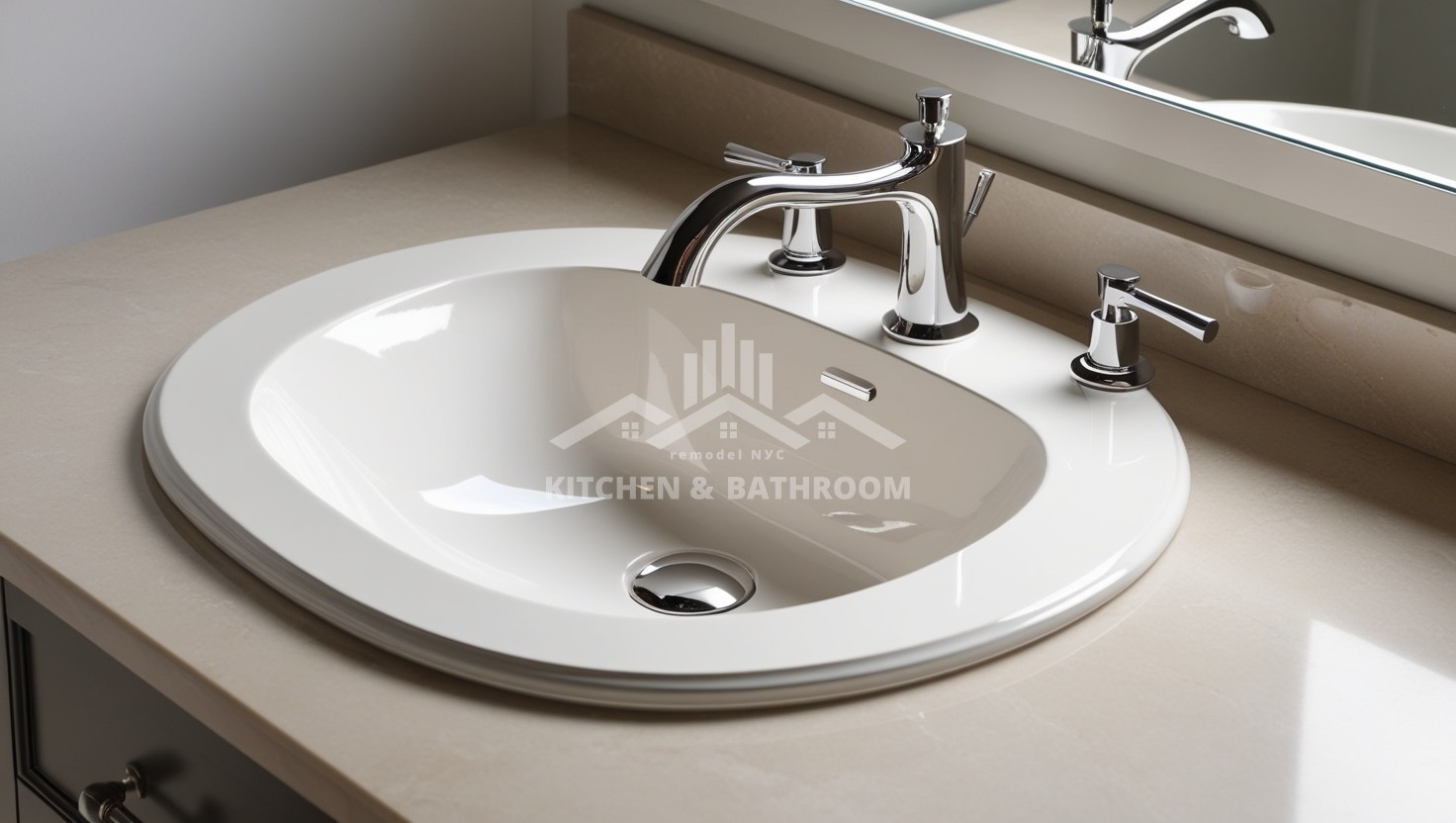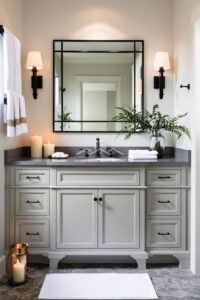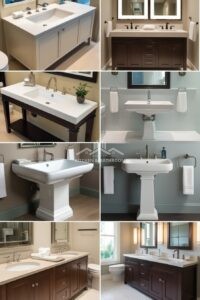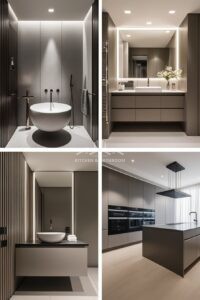
How to Select the Right Sink for Your Single Bathroom Vanity
Single bathroom vanity is an essential focal point in any bathroom design, and selecting the right sink to complement it can make all the difference. At Kitchen and Bathroom Remodeling, we understand that choosing the perfect sink involves balancing style, functionality, and space. Whether you’re aiming for a sleek modern look or a more traditional aesthetic, the right sink can elevate the overall appeal of your vanity and bathroom. In this guide, we’ll walk you through key factors to consider when selecting the ideal sink for your single bathroom vanity.
A Complete Guide to Choosing the Perfect Sink for Your Single Bathroom Vanity
Choosing the right sink for your single bathroom vanity is a decision that combines aesthetics, practicality, and style. It’s more than just a functional item—your sink sets the tone for your bathroom and can be the centerpiece that ties the entire design together. Whether you’re embarking on a bathroom remodeling project or just updating your vanity, selecting the perfect sink is essential. Here at Kitchen and Bathroom Remodeling in E Northport, NY, 11731, we are dedicated to helping you navigate this important decision. In this comprehensive guide, we will explore everything you need to know about choosing the right sink for your single bathroom vanity, ensuring that it enhances both the look and functionality of your bathroom.
The Importance of Sink Selection in Bathroom Remodeling
When you undertake any kind of bathroom remodeling project, whether a small update or a full-scale renovation, the sink is one of the key components that can dramatically impact the room’s design. Your single bathroom vanity will often serve as the focal point, and the sink you choose should align with the overall aesthetic of your space. Selecting the wrong sink can throw off the balance of your bathroom, while the right one can elevate the entire room, making it both visually appealing and highly functional.
The growing trend toward luxury bathroom remodels emphasizes the importance of thoughtful, well-designed fixtures. Today’s homeowners want more than just a functional bathroom—they want a space that reflects their personality, accommodates their lifestyle, and feels like a retreat. The sink you choose should not only be durable and practical but should also harmonize with the other design elements of your custom bathroom remodeling project.

Why Your Single Bathroom Vanity is Crucial
The single bathroom vanity is the centerpiece of most bathrooms, serving as a practical space for daily routines like washing hands, brushing teeth, or putting on makeup. Beyond its functional role, the vanity is an essential design element, often dictating the bathroom’s overall style. Choosing the right sink for this vanity ensures the space works well for your needs while also enhancing its visual appeal.
While double vanities are often chosen for master bathrooms or large spaces, the single vanity is the perfect solution for guest bathrooms, powder rooms, or smaller bathrooms. It offers sufficient countertop space while leaving room for storage underneath. When paired with the right sink, a single bathroom vanity can offer both form and function without overwhelming the room.

Types of Sinks for a Single Bathroom Vanity
Choosing the right type of sink for your vanity depends on several factors, including space, design preferences, and overall functionality. Here, we break down the most popular sink types and their pros and cons to help you make an informed decision.
1. Under-Mount Sinks
An under-mount sink is installed beneath the countertop, creating a seamless look that’s ideal for modern and contemporary bathrooms. These sinks provide a sleek and streamlined appearance, making them a popular choice for homeowners who favor minimalist or clean designs.
Pros:
- Seamless appearance: Because the sink is installed below the countertop, it creates a smooth and cohesive look that complements high-end materials like granite, quartz, or marble.
- Easy to clean: Without any edges or lips to catch dirt, under-mount sinks make wiping down countertops easy and hassle-free.
- Stylish: Under-mount sinks are often found in luxury bathroom remodels due to their sleek appearance.
Cons:
- Requires solid surface countertops: These sinks work best with durable countertop materials like stone or quartz. Laminate countertops may not be suitable.
- Installation costs: Because they need to be attached securely beneath the countertop, under-mount sinks may require professional installation, making them more expensive than other options.
2. Vessel Sinks
A vessel sink sits on top of the vanity countertop, offering a unique, artistic look that can serve as a focal point in your bathroom. Vessel sinks are available in a wide variety of shapes, materials, and sizes, from glass to stone, making them a versatile choice for different design preferences.
Pros:
- Aesthetic appeal: Vessel sinks are often used in luxury home remodels for their artistic flair. They can transform your vanity into a statement piece.
- Variety of materials: You can choose from a wide range of materials, including glass, porcelain, metal, and stone, which allows you to match the sink with your bathroom’s overall style.
- Easy installation: Compared to under-mount sinks, vessel sinks are easier to install since they sit on top of the countertop.
Cons:
- Counter space: Because vessel sinks sit above the countertop, they take up more room than other sink types, reducing usable counter space.
- Cleaning challenges: Vessel sinks often have more exposed surfaces, making them harder to clean, especially around the base.
3. Pedestal Sinks
A pedestal sink stands on its own without the need for a vanity. These sinks are typically used in smaller bathrooms or powder rooms where space is at a premium. They offer a classic, timeless look and are perfect for traditional or vintage-inspired bathroom designs.
Pros:
- Space-saving: Pedestal sinks are ideal for small bathrooms where storage and floor space are limited.
- Classic design: Pedestal sinks have a timeless appeal and can complement a variety of bathroom styles, from vintage to modern.
- Affordable: These sinks are generally more affordable and easier to install than more complex sink types.
Cons:
- No storage: Because pedestal sinks don’t require a vanity, they don’t provide any storage space, which may be a disadvantage for larger or more functional bathrooms.
- Limited countertop space: Pedestal sinks don’t offer any surface area for bathroom essentials, which may be inconvenient in a busy household.
4. Drop-In Sinks
Drop-in sinks are installed by placing the sink bowl into a hole cut into the countertop. The edges of the sink rest on top of the counter, creating a visible lip around the sink.
Pros:
- Easy installation: Drop-in sinks are straightforward to install and can be used with a wide range of countertop materials.
- Affordable: These sinks are often more affordable than under-mount or vessel sinks, making them a practical choice for budget-conscious homeowners.
- Variety of styles: Drop-in sinks come in a variety of materials, shapes, and sizes, making them versatile for different bathroom styles.
Cons:
- Visible lip: The lip around the sink can collect dirt and grime, making it harder to clean.
- Less modern look: Drop-in sinks may not have the same streamlined appearance as under-mount or vessel sinks, making them less popular in modern or minimalist designs.
5. Wall-Mounted Sinks
Wall-mounted sinks are attached directly to the wall, with no need for a vanity or pedestal. These sinks are perfect for small bathrooms or minimalist designs where floor space is limited.
Pros:
- Space-saving: Wall-mounted sinks free up floor space, making the bathroom feel larger and less cluttered.
- Modern look: These sinks provide a clean and minimalist aesthetic that’s popular in modern bathroom designs.
- Accessibility: Wall-mounted sinks are ideal for creating an accessible bathroom, as they can be installed at various heights.
Cons:
- No storage: Like pedestal sinks, wall-mounted sinks don’t offer any built-in storage, which may be a downside for some homeowners.
- Requires sturdy walls: The installation process is more complex, as the sink must be securely mounted to the wall, which may require additional reinforcement.

Factors to Consider When Choosing a Sink for Your Single Bathroom Vanity
Choosing the perfect sink for your single bathroom vanity requires careful consideration of several key factors. Here are the most important things to keep in mind:
1. Space and Size
The size of your sink should be proportionate to the size of your single bathroom vanity. A sink that is too large will dominate the vanity and make the bathroom feel cramped, while a sink that is too small may look out of place.
Tips:
- Measure carefully: Before selecting a sink, measure your vanity and ensure the sink fits comfortably within the available space.
- Consider countertop space: If you use your vanity countertop for storing essentials like soap, toothbrushes, or decorative items, make sure the sink doesn’t take up too much of this space.
2. Style and Aesthetic
The style of your sink should complement the overall design of your bathroom. Whether you prefer a modern, minimalist look or something more traditional, there’s a sink style to match.
Tips:
- Modern bathrooms: For a sleek, modern look, under-mount sinks or wall-mounted sinks work best.
- Traditional bathrooms: If you’re going for a classic, traditional design, consider a pedestal sink or a drop-in sink with decorative detailing.
- Luxury bathrooms: In a high-end, luxury bathroom remodel, opt for premium materials like stone, marble, or glass to create an elegant, upscale appearance.
3. Material and Durability
Sinks come in a wide range of materials, each with its own set of advantages and disadvantages. Choose a material that aligns with your bathroom’s design, maintenance requirements, and budget.
Common Sink Materials:
- Ceramic: Durable, affordable, and easy to clean, ceramic is one of the most popular materials for bathroom sinks.
- Porcelain: Similar to ceramic, porcelain sinks are known for their durability and stain resistance, making them a practical choice for busy households.
- Glass: Glass vessel sinks offer a modern, elegant look but may require more careful maintenance to avoid scratches and stains.
- Stone: Marble or granite sinks provide a high-end, luxury feel but can be more expensive and require regular sealing to prevent damage.
- Stainless Steel: Often used in kitchen remodeling, stainless steel sinks are durable and easy to clean but may not suit every bathroom design.
4. Functionality
While aesthetics are important, you’ll also want to choose a sink that functions well for your daily needs. Consider how you use your bathroom and what features are most important to you.
Questions to Ask:
- Do you need extra countertop space? If you frequently use your vanity for storage, choose a sink that leaves plenty of room for toiletries.
- How easy is it to clean? Some sink materials, like glass and stone, may require more maintenance than others. Choose a sink that fits your cleaning routine.
- Is the faucet compatible? Different sinks require different faucet configurations. Make sure your chosen sink and faucet are compatible in terms of size and installation.
5. Faucet Compatibility
Your sink and faucet should work together to create a cohesive look and provide functional performance. Depending on the type of sink you choose, you may need a specific type of faucet, such as a tall faucet for a vessel sink or a wall-mounted faucet for a wall-mounted sink.
Tips:
- Check the number of holes: Some sinks require multiple holes for faucet installation, while others only need one.
- Choose the right height: Make sure the faucet’s height is appropriate for the sink. A tall faucet may overwhelm a small under-mount sink, while a short faucet may not work with a vessel sink.

Bathroom and Kitchen Remodeling Trends for 2024
At Kitchen and Bathroom Remodeling, we stay up-to-date on the latest design trends to help you create a stylish, functional space that aligns with your needs. If you’re planning a luxury home remodel or updating your bathroom or kitchen, here are some key trends for 2024 to consider.
1. Modern, Minimalist Designs
Minimalism continues to dominate in both bathroom and kitchen remodeling. Clean lines, open spaces, and uncluttered designs are key elements of modern homes. Under-mount sinks, wall-mounted faucets, and floating vanities are all popular choices for creating a sleek, minimalist look.
2. Luxury Features
Homeowners are increasingly looking to incorporate luxury bathroom features into their remodels. This includes everything from high-end materials like marble and quartz to advanced fixtures like touchless faucets and heated floors. A well-chosen sink made from premium materials can add a touch of luxury to any bathroom.
3. Sustainable Design
Eco-friendly and sustainable design is becoming more important to homeowners. In kitchen and bathroom remodeling, this can mean choosing water-saving faucets, energy-efficient appliances, and materials that have a lower environmental impact. Opt for sustainable materials like recycled glass or bamboo to create an eco-conscious bathroom.
4. European Kitchen Designs
In the kitchen, European design is growing in popularity. This trend focuses on sleek, handleless cabinets, integrated appliances, and minimalist designs that make the kitchen feel streamlined and efficient. Custom kitchen remodeling projects can incorporate these elements to create a contemporary and functional space.
FAQ’s Single Bathroom Vanity
What is the best sink for a small bathroom?
In a small bathroom, space-saving sinks like wall-mounted or pedestal sinks are ideal. These options free up floor space and provide a streamlined look.
How much does a quality bathroom sink cost?
The cost of a bathroom sink varies based on the material, design, and brand. A high-quality sink can range from $100 to $600 or more, depending on the type and materials.
What materials are best for bathroom sinks?
Ceramic, porcelain, and stone are all popular materials for bathroom sinks. They are durable, easy to clean, and available in a wide range of styles.
Can I replace my sink without changing my vanity?
Yes, you can replace the sink without replacing the vanity, as long as the new sink fits the existing countertop and faucet setup.
How do I clean my bathroom sink?
Regular cleaning with a non-abrasive cleaner is recommended to prevent scratches and stains. For glass and stone sinks, use a cleaner specifically designed for those materials.
Conclusion
Selecting the right sink for your single bathroom vanity is an important decision in any bathroom remodeling project. With so many options available, it’s essential to consider factors like size, style, material, and functionality to ensure you make the best choice. Whether you’re opting for a sleek under-mount sink, an artistic vessel sink, or a classic pedestal sink, the right sink can enhance your bathroom’s design while meeting your practical needs.
At Kitchen and Bathroom Remodeling in E Northport, NY, 11731, we specialize in helping homeowners create beautiful, functional spaces that reflect their style and preferences. Whether you’re planning a luxury home remodel, upgrading your bathroom vanities, or designing a custom kitchen, our team has the expertise to bring your vision to life. Contact us today to start your remodeling journey and transform your home into a space you’ll love for years to come.